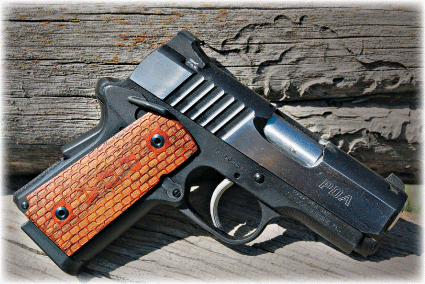When it comes to personal defense, few handguns can equal the 1911. This dependable warhorse has proven itself in combat for more than a century, and today it is more popular than ever.
Two things prevent the 1911 from being a perfect choice for concealed carry, a basic requirement for personal self-defense. First, standard .45ACP 1911s are too bulky for easy concealment, and too heavy for comfortable all-day carrying. Second, while I know the 1911 was designed to be safely carried cocked and locked, I’ve never fully trusted any mechanical safety. Having a loaded and cocked pistol pointing at my nether regions makes me nervous. I’ll carry one in an exposed holster on my belt, but not stuffed inside my pants.
 Gun Details
Gun Details
Para USA addressed these concerns with its new PDA (Personal Defense Assistant) pistol. This 9mm handgun is considerably more compact than its .45ACP counterparts. Measured from the rear of the snubbed-off beavertail to the muzzle, the gun is just 6.25 inches long. From the top of the rear sight to the base of the magazine, the gun stands an even 5 inches tall. Not counting the ambidextrous safety, the slide, which is the only part of the gun you tuck under your belt, is a slim 0.92 of an inch wide. The grip is just 5 inches in circumference, allowing even smallish hands a firm and steady grasp.
Advertisement — Continue Reading Below
The new compact pistol gets high marks in aesthetics. The wooden grip panels exhibit a ladder-style texturing that provide a no-slip grip while adding to the gun’s distinctive appearance. The initials “PDA” also appear on the grip. A 0.75-of-an-inch-wide strip running down each side of the stainless steel slide has an attractive bright, stainless finish, while the remainder of the slide, including the deeply ridged slots your fingers grip when cycling the action, has a contrasting matte black finish. Instead of being slotted, the grip panel screws accept an Allen-head wrench.
This gun was obviously designed with concealed carry in mind. The twin, trimmed-down safety levers project just far enough for easy operation, while the spurless hammer rides flush against the rear of the slide. Trijicon sights front and rear are smoothly streamlined and feature three tritium-powered dots for fast target acquisition even in dim light. There are no projections to snag clothing or impede a smooth draw.
At 24 ounces, the 9mm PDA is considerably lighter than full-sized 1911 pistols. A fully loaded magazine increases heft to 30 ounces, a weight you’ll notice if you wear this gun awkwardly holstered. Don Hume’s JIT Slide No. 10 distributes the PDA’s weight unobtrusively on the outside of your belt. Several manufacturers offer behind-the-waistband holsters. If concealability is more important than a fast draw, the Galco SkyOps is the only holster I’m aware of that completely hides the gun under a tucked-in shirt. The gun is undetectable in the SkyOps holster, but you have to pull your shirttail out with one hand while drawing the gun with the other. It takes a second longer to put the gun in play, but it remains unobtrusively and completely out of sight.
Advertisement — Continue Reading Below
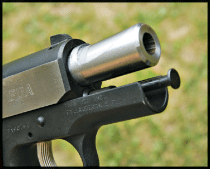 The thing I like best about the PDA is its ground-breaking Para Light Double Action (LDA) trigger. A few years ago, Para USA trumped other pistol makers by figuring out how to convert the 1911’s single-action mechanism into a DAO (double-action-only) gun that can’t be carried cocked and locked. The action features an internal drawbar linking the trigger to the hammer. Cycling the slide partially cocks the action, but allows the hammer to return to its downward position, where it rests against the rear of the slide. Once you de-activate the thumb safety and squeeze the grip, pulling the trigger moves the drawbar rearward. This cams the hammer to the rear, tripping the sear then releasing the mainspring to drive the hammer forward and fire the pistol.
The thing I like best about the PDA is its ground-breaking Para Light Double Action (LDA) trigger. A few years ago, Para USA trumped other pistol makers by figuring out how to convert the 1911’s single-action mechanism into a DAO (double-action-only) gun that can’t be carried cocked and locked. The action features an internal drawbar linking the trigger to the hammer. Cycling the slide partially cocks the action, but allows the hammer to return to its downward position, where it rests against the rear of the slide. Once you de-activate the thumb safety and squeeze the grip, pulling the trigger moves the drawbar rearward. This cams the hammer to the rear, tripping the sear then releasing the mainspring to drive the hammer forward and fire the pistol.
Because the mainspring is already cocked, there’s little resistance for your trigger finger to overcome. After a long, light pull takes up the slack, the trigger breaks crisply at 6.5 pounds. Without my trigger gauge, I’d swear even less pressure was required. The long, two-stage trigger is inherently safer than the single-action hair trigger sometimes found on customized 1911s. The half-inch take-up required before the triggers’ second stage kicks in could prevent accidental firing in a high-stress confrontation. When it’s time to shoot, the trigger offers excellent control. There’s no magazine safety so the gun can be fired without one.
I acquired a single-stack .45ACP Para LDA several years ago, and it sports the same delightful trigger action. This, and the fact I can carry this pistol ready for use without having the hammer visibly cocked, has made this my favorite 1911. The 9mm PDA is smaller, lighter and handier. It’s a mild-mannered little gun that’s a lot of fun to shoot.
Advertisement — Continue Reading Below
While the .45ACP is a better manstopper, the 9mm is a perfectly adequate defensive round, particularly with jacketed hollowpoints. Lower recoil should make this 9mm easier to control than the .45ACP version that’s sure to come along. Also, its 8 + 1 round capacity puts two more shots on tap compared to a like-sized .45.
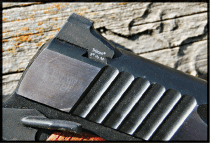 While its 1911 heritage is obvious, the new PDA departs from John Browning’s original design in several important ways. In addition to its compact size and ambi, trimmed-down (but highly functional) safety levers, this gun sports a tapered barrel that eliminates the need for a bushing up front. The bulbous muzzle ensures a snug barrel-to-slide fit when the gun is in battery. The result is more than adequate accuracy and an aesthetically pleasing design.
While its 1911 heritage is obvious, the new PDA departs from John Browning’s original design in several important ways. In addition to its compact size and ambi, trimmed-down (but highly functional) safety levers, this gun sports a tapered barrel that eliminates the need for a bushing up front. The bulbous muzzle ensures a snug barrel-to-slide fit when the gun is in battery. The result is more than adequate accuracy and an aesthetically pleasing design.
I’ve already mentioned the most important distinction; the ingenious light, double-action trigger design that sets the PDA (and other LDA Paras) apart from all other 1911s. What’s more, this gun isn’t simply a downsized .45ACP. It features a frame and magazine specifically engineered to digest 9mm cartridges.
Advertisement — Continue Reading Below
Like most 1911-style pistols, the PDA features natural “pointability.” The gun feels good in my hand and lines up on the target seemingly without conscious effort. The “three-white-dot” picture the Trijicon sights provide makes precise aiming fast and easy whether you grip the gun with one hand or two. The rear-sighting slot and front blade are generously proportioned and squarely cut, with sufficient space visible on either side of the blade for fast target acquisition. The rear sight is mounted to the slide via a sturdy dovetail, and is drift-adjustable for windage.
All the controls line up where they should. Thanks to a slender grip, I can easily depress the magazine release without shifting my thumb, something I can’t say about some of the high-capacity 1911s I’ve used that sported the oversized grip required to house a double-stack magazine. The single-stack PDA is perfectly suited to my hands, while the grip safety is positive and unobtrusive. I appreciated the lack of a long, projecting beavertail on this gun.
While the Para PDA is built on the basic 1911 design, the LDA trigger with its drawbar link to the hammer, the absence of a barrel bushing, and other design differences mean the disassembly process is slightly altered. Instead of first removing a barrel bushing to relieve tension on the recoil spring, you must rack the slide rearward far enough to line up the slide stop lug with the disassembly notch in the slide. Then you must firmly grasp the partially retracted slide and the receiver with one hand (remember, the slide is still under spring pressure), and hold it in position while you press out the slide stop with the other hand. This takes practice and strong fingers. From that point on, disassembly is pretty straightforward.
Advertisement — Continue Reading Below
Fortunately, the “Safety and Instruction Manual” accompanying the PDA has clearly written,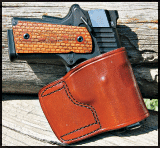 easy-to-follow instructions, along with helpful photographs. Without the help of the manual, I’d still be trying to figure out how to take the gun apart.
easy-to-follow instructions, along with helpful photographs. Without the help of the manual, I’d still be trying to figure out how to take the gun apart.
In addition to giving basic takedown instructions, the manual shows you how to strip out the power extractor assembly, and how to disassemble and clean the magazine. Detailed steps are even provided for properly breaking in the pistol before you carry it on a regular basis. The instructions go on to specify that four drops of oil are all that’s needed to properly lubricate the gun. One drop goes into each of grooves in the slide, another goes on the barrel immediately behind the muzzle, while the fourth drop should be applied through the ejection port on top of the barrel hood. I’ve seen a lot of instruction manuals in my time, but the Para book is the best I’ve run across. It covers all the bases in easy-to-understand detail. Full-color photos illustrate each step.
Range Time
At my desert range, I ran a variety of Hornady, Remington and Black Hills 115- and 124-grain loads through the gun. The PDA’s oversized Para Power Extractor made sure no brass hung up in the chamber. I fired more than 300 rounds without the benefit of cleaning. The only malfunctions occurred when I purposely “weak-wristed” the pistol. All autopistols require a firm grip, but I’ve found this to be particularly true with compact guns like the PDA. Give it a firm, locked-wrist support, and the pistol should feed and fire without a glitch. Dependability is an absolute requirement for personal-defense firearms, and the PDA gets high marks here. Factory loads were used exclusively including “remanufactured” Black Hills ammo. Because of minor dimension variations possible with handloads, I’d recommend feeding a pistol like the PDA factory fodder only for serious social use.
Advertisement — Continue Reading Below
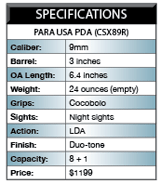 Accuracy was surprisingly good, considering the PDA’s diminutive size and 3-inch barrel. Instead of testing from the 7-yard “close combat” range, I moved the target just over twice that distance away. Firing 115-grain Black Hills JHP ammo from the unsupported offhand position, I was able to print five-shot groups that averaged 3.25 inches between centers. When I closed the range to 7 yards, groups shrank to just under 2 inches.
Accuracy was surprisingly good, considering the PDA’s diminutive size and 3-inch barrel. Instead of testing from the 7-yard “close combat” range, I moved the target just over twice that distance away. Firing 115-grain Black Hills JHP ammo from the unsupported offhand position, I was able to print five-shot groups that averaged 3.25 inches between centers. When I closed the range to 7 yards, groups shrank to just under 2 inches.
Final Notes
I seldom put a new gun through its paces without finding some negative things to carp about, but that’s not the situation here. If this gun has any faults, I didn’t discover them during the limited testing I performed. I asked a few knowledgeable friends to shoot the PDA, and then give me their opinion. The answers were unanimous. This is a great little gun.
